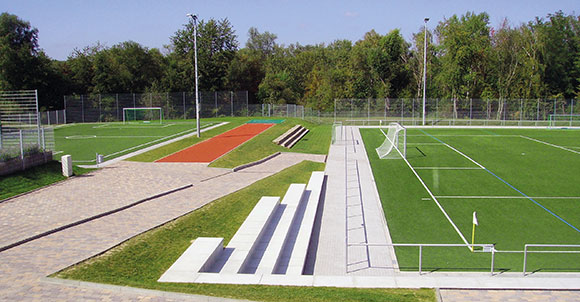

The damage that can be caused by thunderstorm activity has resulted in greater emphasis being placed on protection measures against lightning strikes on floodlights, spectator galleries, fences or even playing fields, which can endanger sportspersons and spectators. People who are directly hit by lightning, or stand next to lightning current carrying objects or who, as a result of a flashover may even be carrying partial lightning current themselves, could sustain serious injuries or possibly die. Moreover, those who are not directly hit by the lightning, but are standing next to the point of strike (potential gradient area) bridge a life-threatening voltage difference with their legs (step voltage) or by touching other people. This may result in injuries such as ventricular fibrillation, cardiac arrhythmia and injuries caused by fright. Therefore, as a recommendation, Dehn Africa advises that effective lightning protection be installed for playing fields and sport grounds, as well as the nearby spectator galleries.
The lightning protection installation requires the following measures to be considered:
• Structures that could easily be struck by lightning must be equipped with permanent effective lightning protection systems.
• It is crucial to recognise these areas as hazards, so that dangerous areas can be evacuated and buildings or designated shelters can be sought in the event of a thunderstorm.
• Additional lightning protection measures reduce the risk of injuries in critical areas that contain floodlights, metal fences and escape routes.
Lightning protection for buildings
Covered stands, locker rooms and clubhouses provide shelter in case of unexpected heavy rainfall and thunderstorms. A lightning protection system (LPS) according to Lightning Protection Level (LPL) III as per SANS 62305-3 (IEC & EN62305-3) is at least required for these types of structures. In the event of a lightning strike, partial lightning current may also flow through metal fences, parts of the spectator gallery and flagpoles or even the scoreboards. This could result in an uncontrolled flashover, which may cause fire and jeopardise people and animals in close proximity. In order to prevent this, all conductive elements in the LPS, like railings down conductors, fencing, etc. should be equipotentially bonded to earth. After this, the installation of a LPS to the 230/400 V power supply system at the entry point of the main low-voltage distribution board, such as a DEHNventil or a DEHNshield combined arrestor, is required. In addition, the associated lightning equipotential bonding system for metal and electronic systems prevents fire in these structures.
Isolated air-termination system
According to the latest lightning protection standards, an isolated air-termination system can be used to protect metal floodlight pylons, parts of the spectator gallery, scoreboards and flagpoles against direct lightning strikes. Isolated air-termination systems, such as the DEHNconductor HVI system (high-voltage-resistant, insulated conductor), can prevent flashover. Consequently, no lightning currents will travel through these structures, thus preventing dangerous lightning currents from flowing into sensitive electrical systems. The height of the air-termination tip depends on the relevant class of LPS, which must be determined in advance. The HVI conductor can be installed at the pylon in line with the installation instructions using system-specific accessories to prevent lightning currents from flowing through the pylon and the rest of the installation.
Lightning protection for floodlights
Floodlights next to the sideline or spectator galleries should also be provided with a lightning protection system. The earth-termination systems of the individual pylons should be connected to each other and to the earth-termination systems of the sports buildings. These additional connections improve equipotential bonding and the efficiency of the individual foundation earth electrodes. If correctly installed, they form a protected volume in case of a direct lightning strike to the cable routes of the floodlight.
Standing surface insulation, touch and step voltage (potential control)
People standing directly next to lightning current carrying floodlight pylons, fences, flagpoles or grandstands during a lightning strike are exposed to high potential differences with their legs (step voltage) or may directly touch conductive structures (touch voltage). The potential risk and injury can be reduced by insulating the standing surface (standing surface insulation), and this measure reduces the risk of impermissibly high touch and step voltages following a lightning strike. According to SANS 62305 (IEC/EN 62305), an insulating asphalt layer of at least 5 cm around these parts is sufficient.
Potential control also allows step voltages to be reduced by additional earthing conductors that are buried around the pylons or metal spectator galleries and interconnected. Consequently, the potential difference in the probable control area is reduced and the lightning current is evenly distributed in the ground. The more evenly the earth electrodes are installed, the lower the potential difference (step voltage). Thus, the risk of injury is considerably reduced.
For more information contact Kirk Risch, Dehn Africa, +27 (0)11 704 1487, [email protected], www.dehn-africa.com

© Technews Publishing (Pty) Ltd | All Rights Reserved